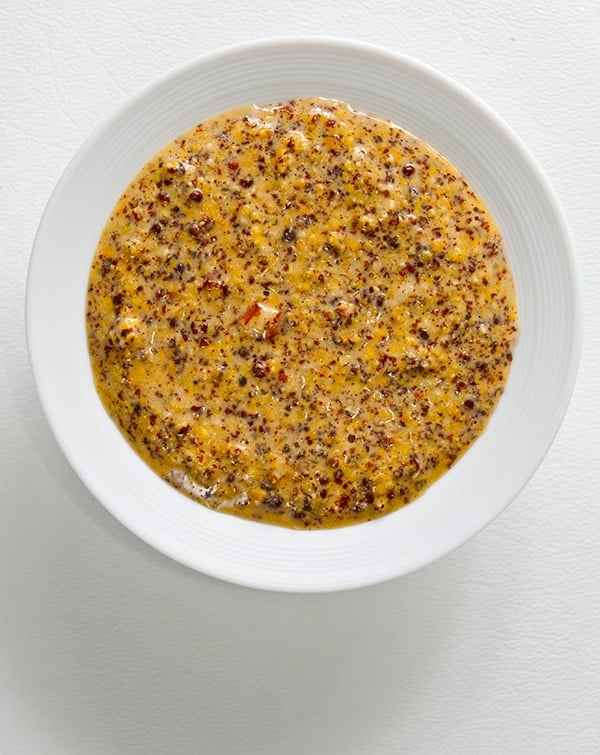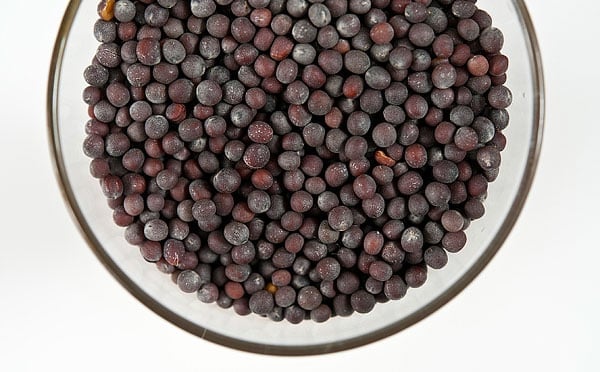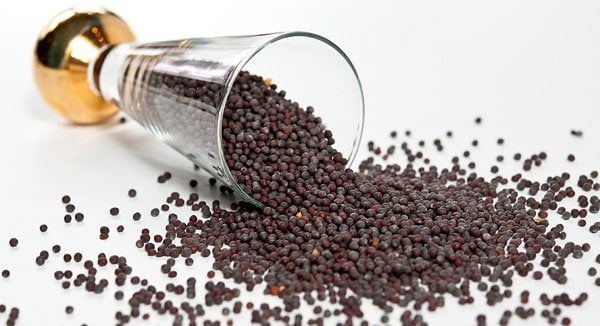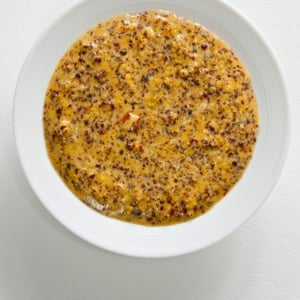As an Amazon Associate I earn from qualifying purchases.

What do you mean you can make mustard at home? It was all I could do not to say, “Uh… how did you think it was made? By mustard elves under a tree?” Instead, I said, “Why yes, and it is really, really easy to make.”
I had this conversation years ago with another food blogger, and I tell you this because for even a food person to not know how to make mustard tells me that it must appear to be magic to most people. But it ain’t. If you have mustard seed and water, you can make mustard.
It’s that easy. And pretty much every culture in the Northern Hemisphere has done so: Mustard is to the North what chiles are to the tropics.
Mustard is a condiment of a thousand faces. Some are smooth, others almost entirely made from barely cracked seeds. Vinegar is often used, but wine, beer, grape must, and even fruit juices are used to moisten the seeds.
Sweetness is usually achieved by adding honey; an American “honey mustard” can be a 1:1 ratio of mustard to honey. A Bavarian sweet mustard, however, uses only sugar and water: no acid, no honey. Italians put fruit preserves in their mustard.
Mustard is one of Europe’s few native spices, although it also has been used in Chinese cooking for around 2,500 years as well. Ancient Rome was quite the hotbed of mustard-making, and it is Rome that gives us our name for mustard: It is a contraction of mustum ardens, or “hot must;” the Romans often added crushed mustard seeds to unfermented crushed grapes.
I’ve recreated a Roman recipe for mustard that uses almonds, pine nuts, mustard seed and red wine vinegar.
The basic idea behind making mustard is this: Grind seeds and add liquid. At its most basic, this is all mustard is. Both Chinese and English mustard (think Coleman’s) is nothing more than water and mustard powder. But there are some things you need to know to make great mustard.
First, you need cold liquid. What gives mustard its bite is a chemical inside the seeds reacting with cool or cold liquid. You also need to break the seeds to get at the fiery chemical — it’s like cutting an onion. Heat damages this reaction, however, so to make a hot mustard use cold water, and warm water for a more mellow mustard.
Mustard sauces lose punch when long-cooked, and should always have a little extra fresh mustard tossed in at the end of cooking.
This reaction is volatile, too. Left alone, your mustard will lose its bite in a few days, or in some cases even hours. But adding an acid, most often vinegar, sets the reaction in place — this is what happens with horseradish as well. Adding salt not only improves the flavor, but also helps preserve the mustard, too.
If you skip the vinegar and salt, you will still have mustard, but it will not keep for long. Not that it will go bad, but it will lose it’s flavor.
Once made with salt and vinegar, mustard is nearly invulnerable to deterioration. Mustard is one of the more powerful anti-microbial plants we know of, and, considering it is mixed with vinegar and salt, it becomes a heady mix no wee beastie can survive in. It is said that mustard will never go bad, although it can dry out.
You have three choices when it comes to which variety of mustard seed you use: White, brown and black. White mustard undergoes a different, milder reaction than do brown mustard or black mustard, which are far zingier. American yellow mustard is made with white mustard seed and turmeric, brown mustards are in most of your better mustards, and black mustard is used in hot mustards or in Indian cuisine.
(Note: You can tame black and brown mustard seeds by soaking them in water overnight before grinding.)

Incidentally, the wild mustard all over California is black mustard. You can thank Father Junipero Serra for that one: He used mustard, which grows like a weed, to mark his travels in Alta California 250 years ago.
The famous Grey Poupon mustard — Dijon has been a center of mustard-making for nearly a millennium now — is traditionally made with stone ground brown mustard and verjus, the tart juice of unripe grapes. I prefer this style of mustard, and most of my homemade mustards are grainy like Dijon. I grind my seeds with a spice grinder, but you could get all old school and use a mortar and pestle.
The best mustards, in my opinion, combine brown or black mustard seeds with yellow mustard powder: The two sets of chemical reactions complement each other and made a more complex mustard.
Always add water or a non-acidic liquid first, let the mixture sit for 10 minutes or so, then add the acid (vinegar, verjus, lemon juice, etc).
Add salt to taste, but it’s typically about 1 to 2 teaspoons per cup of prepared mustard.

Finally, let your mustard set in the fridge or in a cool place for at least a day before you serve it. Bitterness is a byproduct of the mustard reaction, but that bitterness fades after a day or so. Pure mustards can be kept at room temperature, but mustards with other ingredients, like the Roman nut mustard I mention above, should be kept in the fridge.
So there you have it. Easy-peasy. Now you really have no reason to ever buy mustard again.
Basic Country Mustard
Ingredients
- 6 tablespoons mustard seeds, about 50 grams
- 1/2 cup mustard powder, about 50 grams
- 1/2 cup water or beer
- 3 tablespoons vinegar (cider white wine or sherry)
- 2 teaspoons salt, about 5 grams
- 1 teaspoon ground turmeric (optional)
- 2 tablespoons honey (optional)
- 1/4 cup minced fresh herbs (optional)
Instructions
- Grind the whole mustard seeds for a few seconds in a spice or coffee grinder, or by hand with a mortar and pestle. You want them mostly whole because you are using mustard powder, too.
- Pour the semi-ground seeds into a bowl and add the salt and mustard powder. If using, add one of the optional ingredients, too.
- Pour in the water or beer, then stir well. When everything is incorporated, let this sit for up to 10 minutes. The longer you let it sit, the mellower the mustard will be. When you’re ready, pour in the vinegar.
- Pour into a glass jar and store in the fridge. It will be runny at first. Don’t worry, it will thicken up overnight. Wait at least 12 hours before using. Mustard made this way will last a year in the fridge.
Video
Notes
- Change the liquid and you change the mustard.
- Grind the mustard seeds a lot or a little and you change the texture — or skip the whole seeds altogether and use just mustard powder. Or skip the powder and just use seeds.
- Want herbs in there? Go for it.
- Like honey mustard? Pour some honey in.
- Want your mustard even spicier? Add chiles or freshly grated horseradish.
Nutrition
Nutrition information is automatically calculated, so should only be used as an approximation.






I made two different kinds, one with tarragon and one with roasted garlic. I used yellow mustard seeds and rice wine vinegar. Both were EXCELLENT and are gone!! Hubby says no more store bought!! I agree. Tonight I made another roasted garlic and used some left over champagne, roasted garlic again. Can’t wait for this one! Going to make mustard for Christmas gifts along with jam and applesauce made previously!! Fun, fun. Will try the Roman nut mustard when my bulk seeds arrive!! Thanks for the recipes!!
I use 5% vinegar and yellow and black seeds.Let them soak for a day or two and puree’ them.If it’s a little thick I might add wine or malt vinegar.I never use any water,just vinegars.It’s really hard to screw this up.If it’s good to you it’s good.
I made some some mustard with apple cider vinegar and verjus, and it stayed incredibly bitter even after 4 days. Why is that?
Monz: Could be your seeds. Try yellow mustard seeds next time.
What type of beers to you recommend? Dark, ales, hoppy, so many to choose from now days?
Stennis: Depends on your taste. I usually prefer cheap lagers for most, but a porter or brown ale is a nice change.
Thanks for the recipe & history. Don’t use mustard as much as I used to so jars end up being in the way on shelf or in fridge. So looking for rx to make as much as needed when needed (now, a day ahead). Will have to come up with a reason to make this soon.
Can you substitute whiskey or bourbon for the beer ???? Have made this mustard with beer multiple times but i want to expand my horizons
KJ: Yes, you can do that.
What herbs do recommend trying? Is it best to use fresh or dried herbs? If fresh is used, will that effect the amount of time it is safe to eat?
I have been making your recipe for a while and it usually turns out great. I just made a jar on Friday and it seemed funnier than normal and now on Monday afternoon, it is still quite runny. I think I followed the recipe correctly. Any advice on what I can do to thicken it up?
Thanks
David: Add more powdered mustard.
If you put in fresh herbs will it still last a year in the fridge?
Danielle: Not sure, but there is a lot of vinegar in there, so it should.
If you were going to use beer. What type would you use. Thanks.
Glo: I like all sorts, but stouts, ambers and IPAs are my favorite.
My first batch turned out well, thank you for the detailed recipe and instruction. There have been several comments regarding canning & shelf life and you response has typically been that there is no need to boil and “can” and that the shelf life of standard mustard is pretty long and longer if refrigerated.
My question is will boiling/caning hurt the mustard in anyway? I am using standard canning jars for storage of the mustard and giving some as gifts and am concerned that since the lids “pop” since they have not been sealed in a boiling process that folks will be skeptical of the freshness of the mustard.
If I were to can them in a standard boiling process to create the vacuum and seal the lids will it negatively impact the mustard?
Brian: No idea. I have never canned mustard.
You have me really excited to start making mustard. Have you ever preserved horseradish?
Make your own mustard people. I became upset when all the “stone ground” mustard went up in price about 10 or 15 years ago so I started to make my own. It’s cheaper and you know what’s in what you make. Try different vinegars, add fruit, grind finer or coarser There is no limit to what you can do.Small batches are easy. Write down your experiments because sometimes you get a real winner and you want to do it again.
I agree with Charlez. It’s too salty
Marc: Then use less salt. Salt sensitivity is very individual, too. Adjust to your own taste.
What is your source for this volume of mustard seeds?
Man, this recipe is super salty. Would it be better to 1/2 the salt and add more later if required?
Charles: Has to be the salt you are using, or your sensitivity to salt. You are the only person in close to 10 years who has said this recipe is too salty. So yeah, use half of whatever salt you are using, then add more. Right now, to save the batch, make up some more mustard without salt and add it to the first batch.
I usually make a simple mustard with yellow powder mixed to a paste with olive oil. Then thinned out with spice or cider vinegar. I’ll have to try it with salt or honey sometime.
Hank,
I made this and mine turned out way too hot (I didn’t have any brown mustard seeds so I gave it a go using just black seeds) but I already added the vinegar and let it sit for a few days. Any way to rescue it now? Thanks.
Beth: Nope. Black mustard is by far the hottest mustard there is.
Second batch came out runny. Any way to thicken after the refrigeration step?
Rich: Add more mustard powder.
I am so excited to try!
Have you (or anyone reading) tried a cherry mustard?